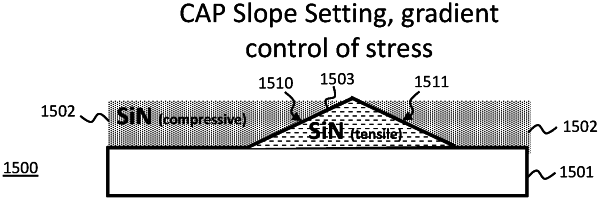| CPC H01L 21/02304 (2013.01) [H01L 21/0217 (2013.01); H01L 21/31053 (2013.01); H01L 21/31111 (2013.01)] | 15 Claims |

|
1. A method of adjusting stress on a substrate, the method comprising:
depositing a first layer of a first material on the substrate;
depositing a second layer of a second material on the first layer, wherein the first layer and the second layer are deposited on a backside surface of the substrate opposing a front side surface of the substrate, the front side surface of the substrate including semiconductor devices;
changing a solubility of the second layer at one or more coordinate locations on the substrate, wherein the solubility of the second layer is changed in solubility from a top surface of the second layer down to a predetermined depth into the second layer at each of the one or more coordinate locations, and wherein changing the solubility of the second layer includes creating a transition region defining a predetermined vertical acid diffusion length across the transition region; and
removing soluble portions of the second layer using a developer such that remaining portions of the second layer include a predetermined physical slope in the transition region from the top surface of the second layer down to the predetermined depth into the second layer, wherein the predetermined physical slope is greater than 15 degrees and less than 75 degrees, and wherein the first material and the second material have a same molecular composition and different internal stresses.
|